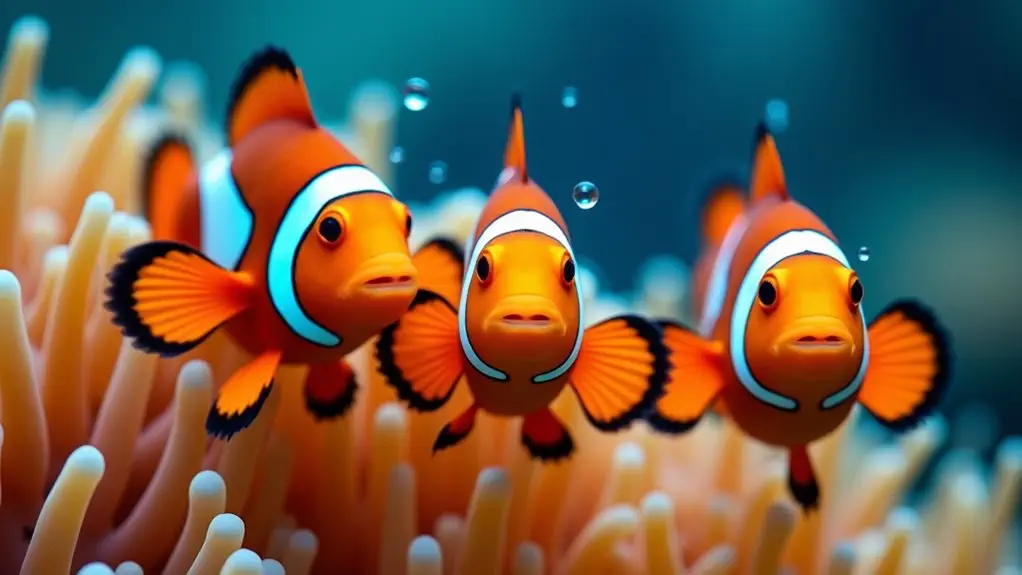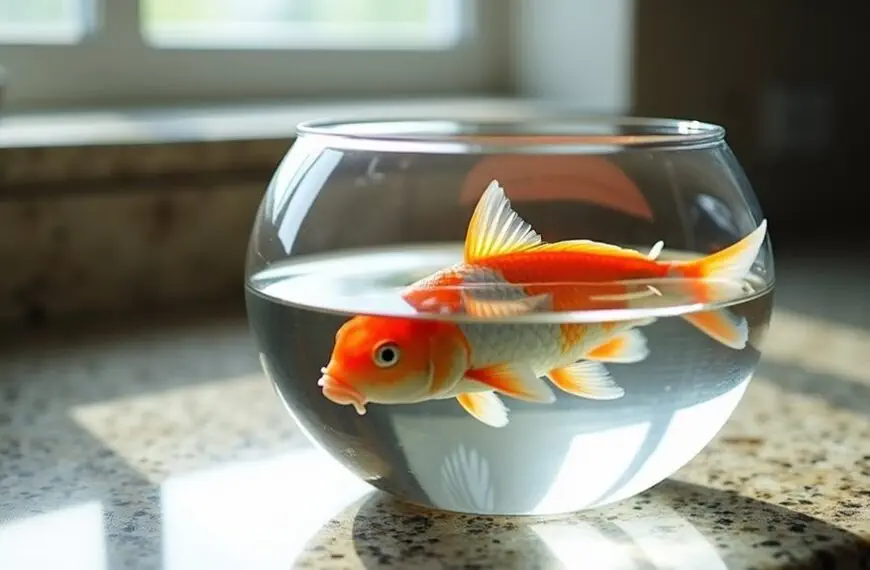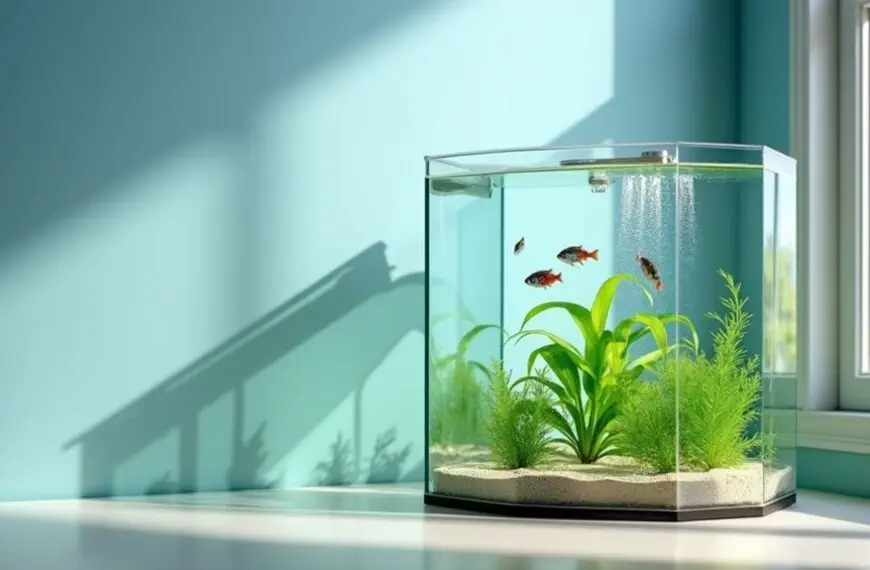You'll know your fish are happy when they display several key behaviors in their aquarium home. Look for active swimming with smooth, purposeful movements throughout the tank, along with bright, vibrant colors that signal good health. Content fish will enthusiastically explore their environment, interact positively with tank mates, and show excitement during feeding time. They should maintain relaxed fins, clear eyes, and consistent swimming patterns while naturally engaging with decorations and plants. If they greet you at the glass and swim in coordinated groups (for schooling species), that's a great sign. There's much more to discover about your aquatic friends' well-being.
Contents
- 1 Signs of a Content Fish
- 2 Understanding Fish Body Language
- 3 Color Changes That Matter
- 4 Watch Their Swimming Patterns
- 5 Eating Behaviors to Monitor
- 6 Social Interactions Among Tank Mates
- 7 Creating the Right Environment
- 8 Daily Health Check Guidelines
- 9 Frequently Asked Questions
- 9.1 Can Fish Recognize Their Owners and Show Excitement When They Approach?
- 9.2 Do Fish Sleep, and How Can You Tell if They're Sleeping Peacefully?
- 9.3 Why Do Some Fish Change Gender, and Does This Indicate Happiness?
- 9.4 Can Fish Hear Music, and Does It Affect Their Mood?
- 9.5 How Long Can Fish Remember Things, and Does Memory Affect Their Happiness?
- 10 Final Thoughts
Signs of a Content Fish
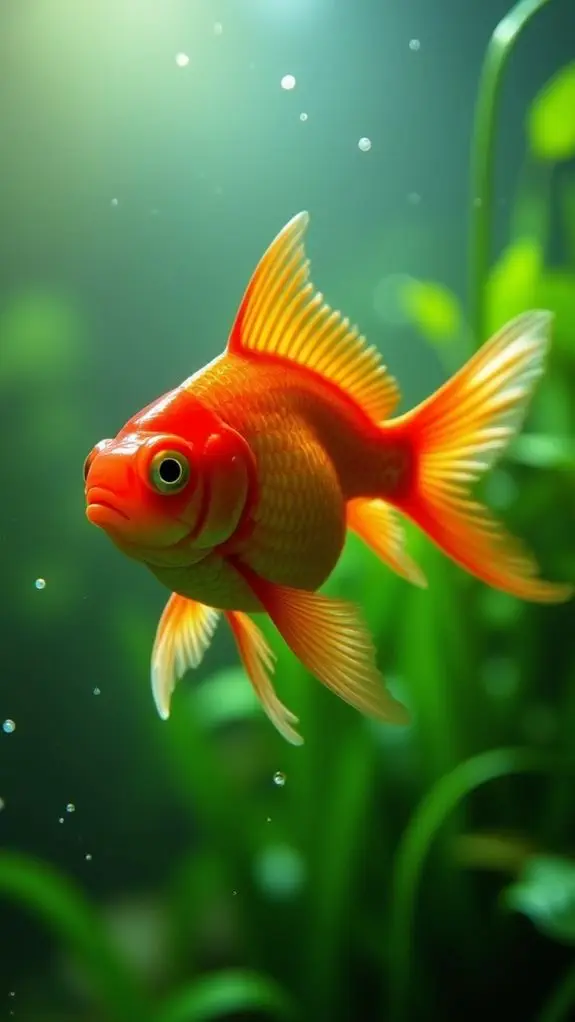
Through careful observation of your fish's behavior, you'll notice several key signs that indicate a happy, healthy aquatic pet. When you see your fish actively swimming throughout the tank, exploring every nook and cranny with zeal, that's a clear signal of content behavior. Similar to how length measurements of wild fish populations help assess their health, observing your pet fish's activity level is crucial. Regular monitoring of water quality parameters ensures that they feel secure in their environment.
Your happy fish will dart playfully from one end to the other, showing curiosity about their surroundings rather than hiding in one spot. A weekly water change is essential for maintaining this happy, energetic behavior.
Keep an eye on your fish's physical appearance too – bright, shiny scales and smooth-moving fins are excellent indicators of their well-being. You'll know you've got a content swimmer when they ardently approach during feeding time and interact confidently with their tank mates.
It's like watching kids in a playground – when fish are happy, they'll explore their underwater playground, weaving through plants and checking out decorations with obvious enjoyment.
Look for fish that demonstrate smooth, relaxed movements and aren't afraid to venture into open areas of the tank. When you spot these behaviors, along with clear eyes and intact fins, you can rest assured that your finned friends are living their best life.
Understanding Fish Body Language
Your fish's body language can tell you a lot about how they're feeling, from their tail flicks and fin positions to their swimming patterns.
Fish often communicate through arched postures when they sense potential threats or changes in their environment. When you're watching your fish, you'll notice that bright, vibrant colors often mean they're happy and healthy, while dull or faded colors might suggest they're stressed. Additionally, fish that display schooling behavior generally feel secure and are thriving in their environment.
Pay attention to how your fish move through the water – smooth, graceful swimming usually means they're content, while erratic movements or hiding could signal that something's not quite right. Look for fish greeting at glass when you approach the aquarium, as this is often a sign they're comfortable and anticipating feeding time.
Tail and Fin Movements
Just as humans communicate through body language, fish express their emotional state through distinct tail and fin movements. When your fish is happy, you'll notice rapid, energetic tail speed and smooth fin coordination as they glide through the water. It's like watching an underwater ballet, where every movement tells a story about their well-being.
You can spot a content fish by observing how they interact with their environment. Happy fish will show consistent, rhythmic tail movements while exploring their surroundings, and their fins will work together harmoniously. Most fish achieve forward motion through lateral body flexion, creating wave-like movements from head to tail. Fish use their ray-reinforced fins for precise control during swimming, which helps them navigate efficiently. Maintaining proper water parameters is essential for supporting their lively behavior.
If you see them actively engaging with toys or decorations using coordinated fin movements, that's a great sign they're feeling their best.
Watch for how your fish interacts with others in the tank. When they're happy, they'll display synchronized swimming patterns and coordinated movements with their tankmates.
Their fins will move independently when they're curious about something new, and you'll notice especially energetic tail movements during feeding time.
If your fish's movements become sluggish or erratic, though, it might be time to check if something's bothering them.
Color Changes Tell Stories
Like silent storytellers in an aquatic world, fish communicate their well-being through vibrant color changes and patterns. Understanding this fascinating color psychology can help you determine if your finned friends are thriving or need attention.
When your fish display bright, vibrant hues, they're usually telling you they're happy and healthy – it's like their way of giving you a thumbs up! In clear water conditions, your fish will display their most vivid colors and communicate more effectively with their tank mates. Maintaining optimal pH levels is crucial for this vibrancy, as fluctuations can lead to stress in fish.
You'll notice that happy fish maintain their natural coloration and might even become more vivid during social interactions or breeding seasons. Regular monitoring of your fish's aquarium behavior can help you assess their overall contentment levels.
However, if you spot your fish losing their brilliant colors or becoming pale, they might be stressed or unhappy. Think of it as their version of "feeling blue." Common triggers for color loss include poor water quality, aggressive tank mates, or illness.
Keep in mind that some color changes are perfectly normal throughout your fish's life. Just like humans go through appearance changes as they age, fish naturally adjust their colors during different life stages.
What's important is learning your fish's typical coloration patterns so you can quickly spot when something's not quite right.
Swimming Pattern Assessment
Swimming patterns reveal volumes about a fish's emotional and physical state, much like how body language helps us understand human behavior. When you're watching your aquatic friends, you'll notice their swimming behaviors tell quite a story about their well-being.
Your fish are likely happy and healthy when they're swimming at a steady, relaxed pace while exploring their environment. If you see them darting around frantically or swimming erratically, these could be stress indicators that something's not quite right in their world. Think of it as the difference between someone taking a casual stroll versus running away from something scary! Angelfish move gracefully through the water when feeling content. Routine water quality tests are essential to maintain a stable environment for your fish. Relaxed fins indicate they're comfortable in their environment.
You'll want to keep an eye out for consistent swimming patterns, which typically signal your fish are feeling right at home. Some species, like tetras, naturally zip around more than others – that's just their playful personality!
However, if you notice a usually calm fish suddenly swimming rapidly or a typically active fish becoming lethargic, it's time to check their environment. Remember, happy fish generally maintain steady, purposeful movements while showing interest in their surroundings.
Color Changes That Matter

Fish colors tell a remarkable story about their well-being. Just like a mood ring changes with your emotions, your fish's color psychology reveals significant clues about their happiness and health. When you're looking at your aquatic friends, vibrant, bright colors generally signal they're thriving, while dull or fading hues might suggest something's not quite right in their underwater world.
Understanding species adaptation is essential because different fish display unique color patterns. You'll notice that some species, like the clever hogfish, can change their colors to match their surroundings – it's their natural survival instinct at work.
But if you see unexpected color changes in your fish, pay attention, as it could be their way of telling you something's off. To ensure your fish remain healthy and vibrant, regularly monitor water quality parameters to catch any issues early.
Keep an eye on your tank's environment, as it plays a huge role in your fish's coloration. If your once-vibrant fish starts looking a bit washed out, check your water quality and make sure the tank isn't overcrowded.
Think of it as your fish's personal mood lighting – when the conditions are right, they'll show off their most dazzling colors!
Watch Their Swimming Patterns
You'll notice healthy fish swim confidently throughout their tank, using different zones and depths with smooth, purposeful movements.
Their swimming speed should be consistent and natural, not erratic or sluggish, and they'll move with an energetic curiosity that shows they're comfortable in their environment.
If you've got schooling fish like tetras or danios, they should be swimming together in groups, which is one of the clearest signs that they're happy and thriving. Additionally, maintaining optimal tank environment requirements like good filtration and regular water changes supports their overall wellbeing.
Normal Swimming Zones
Understanding swimming zones is essential for monitoring your fish's happiness and well-being. In natural lake zones, fish carefully choose their locations based on specific needs, much like how you'd pick the perfect spot in your home. These aquatic environments provide different food sources and shelter dynamics throughout the year, creating a delicate ecological balance.
You'll notice that happy fish actively explore their habitats, moving between zones as seasonal changes occur. In your aquarium, they should display similar behavioral patterns to their wild counterparts. When you're observing your finned friends, you'll see them utilizing different areas of the tank, just as they'd in nature's zones.
To guarantee your fish are content, try to recreate these natural zones in your aquarium. If you notice your fish consistently swimming in specific areas, they're likely following their instincts from their native habitats.
For example, some fish might prefer staying near plants (like in the littoral zone), while others enjoy open water swimming (similar to the limnetic zone). These preferences aren't just random – they're signs that your fish are comfortable and following their natural inclinations. Additionally, providing a well-cycled tank is crucial for maintaining a stable environment that supports their natural behaviors.
Speed and Movement Patterns
When monitoring your aquarium's inhabitants, their swimming patterns can reveal volumes about their well-being. Your fish's swimming speed and movement variety can tell you if they're living their best life or if something's troubling them. Happy fish are like tiny underwater acrobats, gracefully gliding through different areas of the tank and showing off their natural curiosity.
You'll notice content fish display smooth, consistent movements as they explore their environment. They won't just hang out in one spot like couch potatoes – they'll actively swim around, checking out various tank levels and interacting with tank mates. If you've got playful species, you might even catch them chasing each other or investigating new decorations you've added.
However, if you spot your fish moving sluggishly, staying in one place for too long, or swimming erratically, it's time to pay attention. These behaviors could signal stress or health issues that need addressing. Additionally, ensure that optimal pH levels(6.5 to 7.5) are being maintained in your tank, as they are crucial for the health and happiness of your fish.
Keep an eye on their appetite too – happy fish are usually enthusiastic eaters who don't miss a meal. Remember, maintaining good water quality and avoiding overcrowding will help keep your aquatic friends swimming happily.
Group Swimming Behavior
Among the most reliable indicators of fish happiness is their group swimming behavior. When you observe your aquatic pets moving together in harmony, you're witnessing complex social structures at work. Happy fish display confident, coordinated movements and maintain strong group dynamics that benefit every member of their underwater community.
You'll know your fish are thriving when you notice:
- They're swimming together in smooth, graceful formations rather than darting around nervously.
- They're actively engaging with tankmates through playful interactions and synchronized movements.
- They're displaying vibrant colors while participating in group activities.
Watch how your fish navigate their environment as a unit. When they're content, they'll explore their surroundings together, showing curiosity without fear. This collective behavior isn't just beautiful to watch – it's actually helping them conserve energy and stay safe. Additionally, keeping a peaceful fish type in your tank promotes harmonious interactions, contributing to their happiness.
They'll create organized patterns while swimming, and you'll notice they're breathing steadily without hanging out at the surface. It's like watching an underwater dance party where everyone knows the steps!
Just remember to check that no fish are being excluded from these social gatherings, as that could indicate stress or hierarchy issues.
Eating Behaviors to Monitor
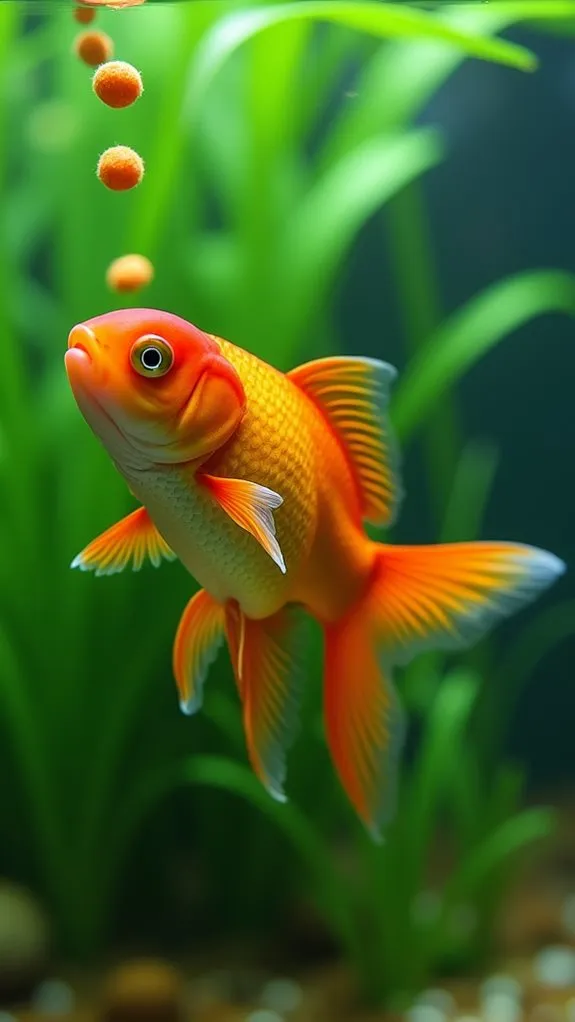
Monitoring your fish's eating habits provides vital clues about their overall well-being. When you maintain a consistent feeding frequency and understand your fish's food preferences, you'll quickly notice if something's amiss. Happy fish typically show enthusiasm during meal times, enthusiastically swimming to the surface or their preferred feeding zone when it's time to eat.
You'll want to watch how your different fish species approach their meals. Surface feeders like tetras should dart excitedly for floating flakes, while bottom feeders such as catfish should actively scavenge near the substrate. If your normally food-motivated oscar isn't showing its typical predatory behavior, or if your goldfish isn't gently nibbling as usual, it might be time to investigate further.
Keep an eye out for red flags in eating patterns. If your fish are hiding during feeding time, leaving food uneaten, or showing irregular feeding habits, they might be stressed or unwell. Remember, just like us on a bad day, fish can lose their appetite when they're not feeling their best.
Maintaining good water quality and providing appropriate food types will help guarantee your finned friends stay happy and hungry.
Social Interactions Among Tank Mates
Beyond feeding behaviors, your fish's social interactions tell a compelling story about their happiness and well-being. When you observe your aquatic friends, you'll notice that happy fish display distinct social dynamics through their daily activities. They'll swim energetically together, explore their surroundings, and engage in playful behavior without showing signs of aggression or stress.
To maintain positive interaction frequency, watch for these three heartwarming signs that your fish are living their best lives:
- Your fish swim together in groups like best friends at a party, showing off their vibrant colors and flowing fins.
- They're curious explorers, checking out tank decorations together without fighting over territory.
- They greet each other like old pals, without any fin nipping or aggressive chasing.
Remember that every fish has its own personality, just like people do. You might notice some establishing hierarchies or preferred swimming buddies. That's completely normal!
If you see your fish hiding more than usual or showing rapid breathing, it could mean they're experiencing social stress. Keep an eye on these behaviors and adjust their environment if needed to guarantee everyone's getting along swimmingly.
Creating the Right Environment
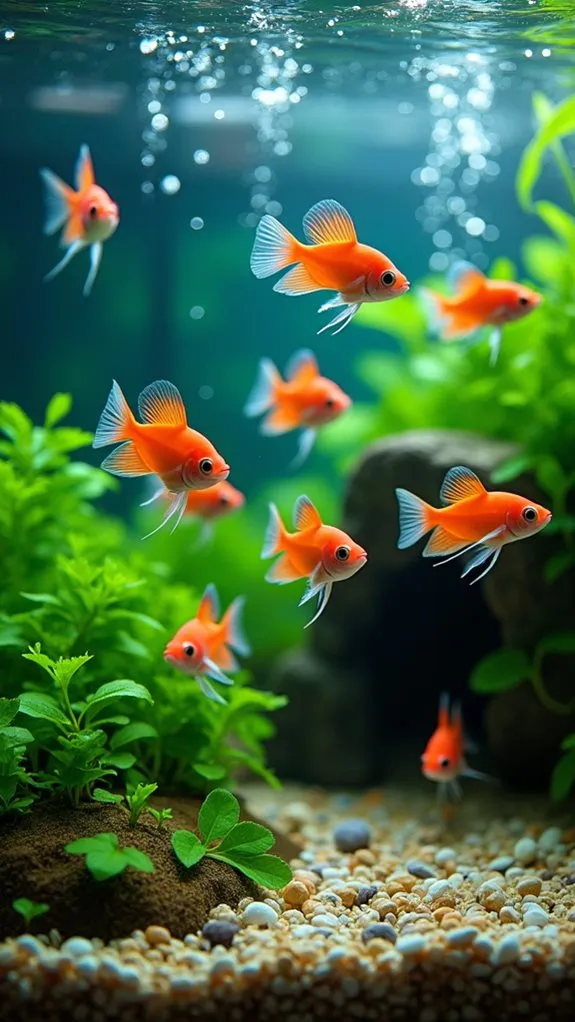
Creating a happy home for your fish starts with maintaining the right environmental conditions in your aquarium. You'll need to focus on tank environment factors like oxygen levels, which are essential for your fish's survival. Make sure you're providing plenty of surface agitation to help with gas exchange and keep those oxygen levels where they need to be.
Water quality is another key factor in your fish's happiness. You'll want to perform regular water changes – about 25% every two weeks – to remove harmful nitrates and keep the water clean. Don't forget to let new water stand and treat it before adding it to your tank!
The habitat complexity of your aquarium matters too, so include features like aquatic plants, rocks, and logs that mimic your fish's natural environment. Pay attention to substrate stability when cleaning, as it houses beneficial bacteria.
Your filtration systems should be working efficiently, and temperature regulation needs to be consistent. Remember that light conditions affect both your fish and any plants you've added.
When you create this balanced environment, you'll notice your fish showing signs of contentment through their active, natural behaviors.
Daily Health Check Guidelines
Regular health checks will help you spot potential problems before they become serious issues. As a responsible fish owner, you'll want to develop daily observation techniques that include watching your fish's swimming patterns, eating habits, and social interactions.
When you're checking on your aquatic friends each day, pay special attention to their coloration and activity levels, as these can be key stress indicators.
- Watch how your fish moves – if they're zipping around playfully and exploring their environment like tiny underwater adventurers, that's a great sign!
- Look for bright, gleaming scales that sparkle like underwater jewels – dull or patchy coloring might mean your fish isn't feeling their best.
- Notice their appetite – a fish that attacks their food with gusto is usually a happy fish!
Make it a habit to document any changes you notice, whether it's unusual breathing patterns or changes in social behavior.
You don't need fancy equipment – just your eyes and attention to detail. If something seems off, don't wait to take action; early intervention can make all the difference in your fish's health and happiness.
Frequently Asked Questions
Can Fish Recognize Their Owners and Show Excitement When They Approach?
Yes, your fish can recognize you through their advanced pattern recognition abilities. They'll show owner recognition by displaying excited fish behavior like active swimming, darting movements, and increased interaction when you approach their tank.
Do Fish Sleep, and How Can You Tell if They're Sleeping Peacefully?
Yes, fish do sleep! You'll notice peaceful behavior when they're resting: minimal movement, slower breathing, and hovering near the bottom. Their sleep patterns include staying upright and being less responsive to stimuli.
Why Do Some Fish Change Gender, and Does This Indicate Happiness?
You'll find that fish gender fluidity is driven by survival, not happiness. They change sex based on social dynamics, temperature, and hormonal triggers to maximize reproductive success in their group or environment.
Can Fish Hear Music, and Does It Affect Their Mood?
Yes, your fish can detect music vibrations through their lateral lines and internal ears. They show sound sensitivity to different types of music, and it's been proven to affect their behavior and activity levels.
How Long Can Fish Remember Things, and Does Memory Affect Their Happiness?
Your fish's memory retention can last several weeks to months, and their cognitive abilities affect happiness. When they remember positive experiences and familiar environments, they're more likely to show signs of contentment and well-being.
Final Thoughts
Keeping your fish happy isn't just about filling their tank with water and tossing in some food. You'll know you're doing things right when you see bright colors, active swimming, healthy appetites, and peaceful interactions among tank mates. Remember, a content fish is a healthy fish, so pay attention to these telltale signs and create an environment where they can thrive. When your fish are happy, you'll find yourself smiling right along with them.

